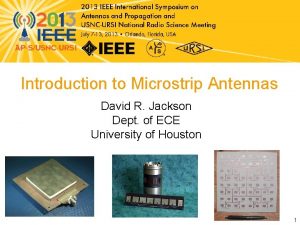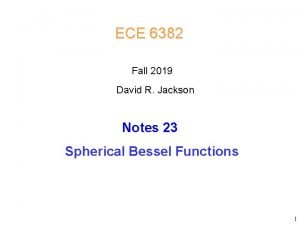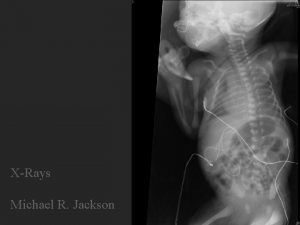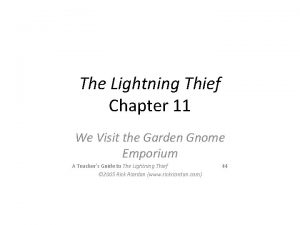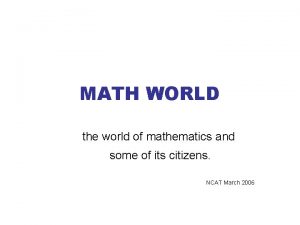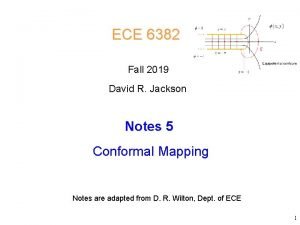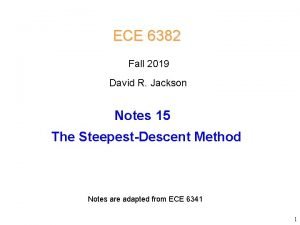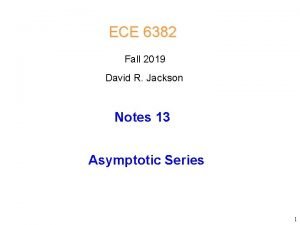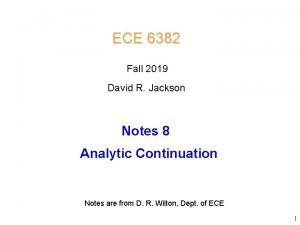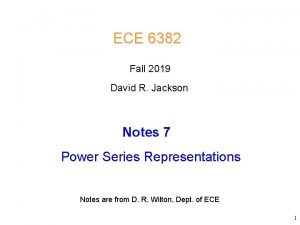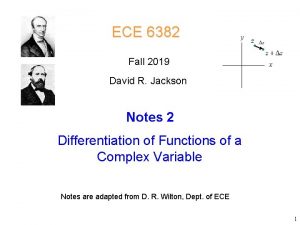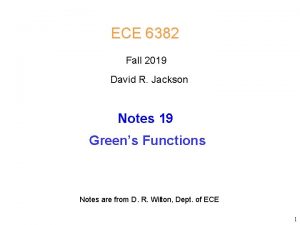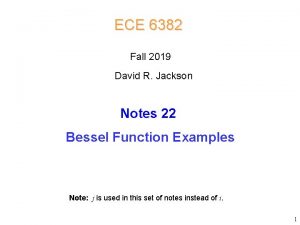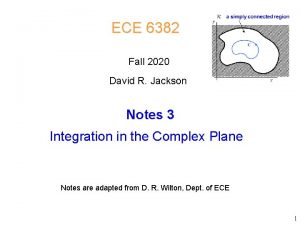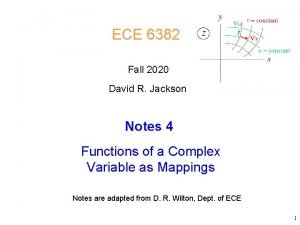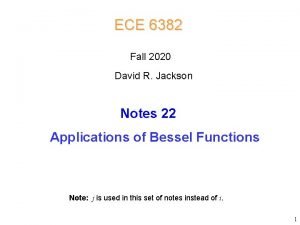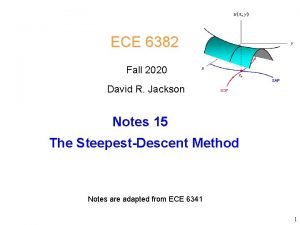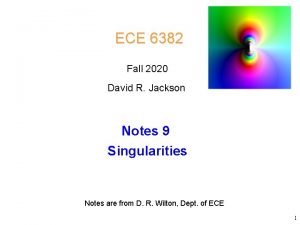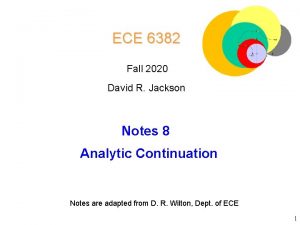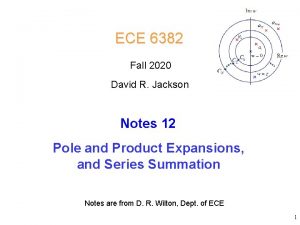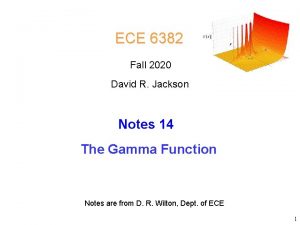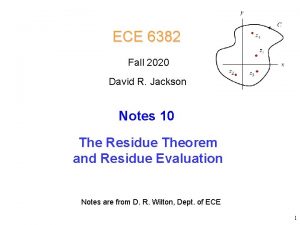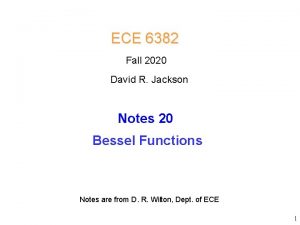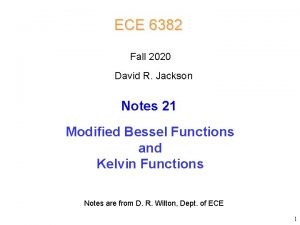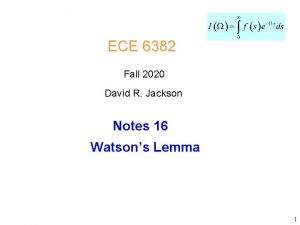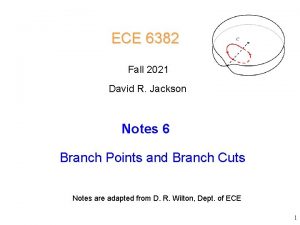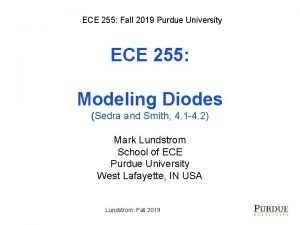ECE 6382 Fall 2019 David R Jackson Notes








































- Slides: 40

ECE 6382 Fall 2019 David R. Jackson Notes 6 Branch Points and Branch Cuts Notes are adapted from D. R. Wilton, Dept. of ECE 1

Preliminary Consider: Choose: There are two possible values. 2

Branch Cuts and Branch Points (cont. ) Consider what happens if we encircle the origin: We don’t get back the same result! 3

Branch Cuts and Branch Points (cont. ) Now consider encircling the origin twice: We now get back the same result! Hence the square-root function is a double-valued function. 4

Branch Cuts and Branch Points (cont. ) Next, consider encircling a point z 0 not at the origin. Unlike encircling the origin, now we return to the same result! 5

Branch Cuts and Branch Points (cont. ) The origin is called a branch point: we are not allowed to encircle it if we wish to make the square-root function single-valued. In order to make the square-root function single-valued analytic in the domain, we insert a “barrier” or “branch cut”. Here the branch cut is chosen to lie on the negative real axis (an arbitrary choice). 6

Branch Cuts and Branch Points (cont. ) We must now choose what “branch” of the function we want. The is the “principal” branch (the MATLAB choice*). Note: MATLAB actually uses - < . The square-root function is then defined on the negative real axis. 7

Branch Cuts and Branch Points (cont. ) Here is the other branch choice. 8

Branch Cuts and Branch Points (cont. ) Note that the function is discontinuous across the branch cut. 9

Branch Cuts and Branch Points (cont. ) The shape of the branch cut is arbitrary. 10

Branch Cuts and Branch Points (cont. ) The branch cut does not have to be a straight line. In this case the branch is determined by requiring that the square-root function change continuously as we start from a specified value (e. g. , z = 1). (This means that the angle changes continuously. ) 11

Branch Cuts and Branch Points (cont. ) Branch points usually appear in pairs; here one is at z = 0 and the other at z = ∞ as determined by examining ζ = 1/ z at ζ = 0. We get a different result when we encircle the origin in the plane, which means encircling the “point at infinity” in the z plane. Hence the branch cut for the square-root function connects the origin and the point at infinity. 12

Branch Cuts and Branch Points (cont. ) Consider this function: What do the branch points and branch cuts look like for this function? 13

Branch Cuts and Branch Points (cont. ) There are two branch points (four if we include the branch points at infinity). There are two branch cuts: we are not allowed to encircle either branch point. 14

Branch Cuts and Branch Points (cont. ) Geometric interpretation 15

Branch Cuts and Branch Points (cont. ) We can rotate both branch cuts to the real axis. 16

Branch Cuts and Branch Points (cont. ) The two branch cuts “cancel”. Both 1 and 2 have changed by 2. Note that the function is the same at the two points shown. 17

Branch Cuts and Branch Points (cont. ) Note: We are allowed to encircle both branch points, but not only one of them! An alternative branch cut. 18

Branch Cuts and Branch Points (cont. ) Example: 4 3 2 1 5 6 7 Suppose we agree that at the point #1, 1 = 2 = 0. This should uniquely determine the value (branch) of the function everywhere in the complex plane. Find the angles 1 and 2 at the other points labeled. 19

Branch Cuts and Branch Points (cont. ) Proceed counterclockwise from point 1. 4 3 2 1 5 6 7 For example, at point 6: 20

Branch Cuts and Branch Points (cont. ) Proceed clockwise from point 7. 4 3 2 1 5 6 7 For example, at point 6: 21

Sommerfeld Branch Cuts Arnold Sommerfeld (1868 -1951) Sommerfeld branch cuts are the most common choice in dealing with radiation types of problems, where there is a square-root wavenumber function. 22

Sommerfeld Branch Cuts (cont. ) First branch: The first branch is defined by: Second branch: Sommerfeld branch cuts 23

Sommerfeld Branch Cuts (cont. ) Proof: First branch: Second branch: As long as we do not cross this hyperbolic contour, the real part of f does not change. Hence, the entire complex plane must have a real part that is either positive or negative (depending on which branch we are choosing) if the branch cuts are chosen to lie along this contour (i. e. , the Sommerfeld branch cuts). 24

Sommerfeld Branch Cuts (cont. ) If the branch cuts are deformed to the hyperbolic choice, the gray area disappears. 25

Sommerfeld Branch Cuts (cont. ) Application: electromagnetic (and other) problems involving a wavenumber. Note: j is used here instead of i. or (The – sign in front is an arbitrary choice here. ) The first branch is chosen in order to have decaying waves when kx > k. The entire complex plane (using the first branch) now corresponds to decaying waves (Im (kz) < 0). 26

Riemann Surface A Riemann surface is a surface that combines the different sheets of a multi-valued function. It is useful since it displays all possible values of the function at one time. (his signature) Georg Friedrich Bernhard Riemann (1826 -1866) 27

Riemann Surface (cont. ) The concept of the Riemann surface is first illustrated for The Riemann surface is really two complex planes connected together. The function z 1/2 is analytic everywhere on this surface (there are no branch cuts). It also assumes all possible values on the surface. Consider this choice: Top sheet: Bottom sheet: 28

Riemann Surface (cont. ) Top Bottom The width of the escalator is collapsed to zero here. Side view Top view 29

Riemann Surface (cont. ) This figure shows going around a branch point twice. Top sheet Branch point 3 D View “Escalator” (where branch cut used to be) Note: We are not allowed to jump from one escalator to the other! Bottom sheet 30

Riemann Surface (cont. ) This figure shows going around a branch point twice. Top View Connection between sheets (escalator) r=1 r 31

Riemann Surface (cont. ) The square root function is analytic on and inside this path, and the closed line integral around the path is thus zero. C C The square root function is discontinuous on this path, and the closed line integral around the path is not zero. 32

Riemann Surface (cont. ) C The 3 D perspective makes it more clear that the integral around this closed path on the Riemann surface is zero. (The path can be shrunk continuously to zero. ) 33

Riemann Surface (cont. ) Top sheet: Defined by 1 = 2 = 0 on real axis for x > 1 There are two sets of up and down “escalators” that now connect the top and bottom sheets of the surface. 34

Riemann Surface (cont. ) Top sheet Bottom sheet The angle 1 has changed by 2 as we go back to the point z = 2. 35

Riemann Surface (cont. ) C 1 , C 2 are closed curves on the Riemann surface. The integral around them is not zero! (The paths cannot be shrunk to zero. ) C 1 , C 2 are closed curves Escalators C 1 C 2 Escalators 36

Riemann Surface (cont. ) Sommerfeld (hyperbolic) shape of escalators 37

Riemann Surface (cont. ) Application to guided waves: Note: j is used here instead of i. Sommerfeld (hyperbolic) shape of escalators Top sheet: surface-wavenumber Bottom sheet: leaky-wavenumber SW LW Leaky waves have a field that increases vertically ( z < 0). 38

Other Multiple-Branch Functions 3 sheets 5 sheets q sheets Infinite number of sheets The power is an irrational number. 39

Other Multiple-Branch Functions (cont. ) Riemann surface for ln (z) Note: There are no escalators here: as we keep going in one direction (clockwise or counterclockwise), we never return to the original sheet. Infinite # of sheets 40
 The life and legacy of andrew jackson
The life and legacy of andrew jackson David r jackson
David r jackson David r jackson
David r jackson Conversion notes brutes en notes standard wisc 5
Conversion notes brutes en notes standard wisc 5 Michael jackson chest
Michael jackson chest Movie about andrew jackson
Movie about andrew jackson Julia louis dreyfus mbti
Julia louis dreyfus mbti Us prior to brown map key
Us prior to brown map key The lottery shirley jackson questions
The lottery shirley jackson questions Walter jackson freeman ii
Walter jackson freeman ii General jackson slaying the many headed monster
General jackson slaying the many headed monster Michael jackson psychodynamic
Michael jackson psychodynamic Andrew jackson trail of tears map
Andrew jackson trail of tears map Why would miss strangeworth be interested in whether linda
Why would miss strangeworth be interested in whether linda Discussion questions for the lottery
Discussion questions for the lottery Why can’t percy simply fight crusty?
Why can’t percy simply fight crusty? What is percy's fatal mistake while battling the chimera
What is percy's fatal mistake while battling the chimera Chapter 12 of percy jackson and the lightning thief
Chapter 12 of percy jackson and the lightning thief Percy jackson and the lightning thief chapter 11
Percy jackson and the lightning thief chapter 11 Chapter 6 lightning thief
Chapter 6 lightning thief The lightning thief chapter 2
The lightning thief chapter 2 Intersurgical jackson rees
Intersurgical jackson rees Peeples middle school
Peeples middle school Sa-sd
Sa-sd Seven types of ambiguity shirley jackson
Seven types of ambiguity shirley jackson Jimi hendrix samuel l jackson
Jimi hendrix samuel l jackson Placa palatina
Placa palatina Mirabeau lamar campaign poster
Mirabeau lamar campaign poster Percy jackson zloděj blesku osnova
Percy jackson zloděj blesku osnova Allusions in percy jackson
Allusions in percy jackson Percy jackson racconta gli dei greci
Percy jackson racconta gli dei greci Percy jackson personages
Percy jackson personages Bohaterowie percy jackson
Bohaterowie percy jackson Percy jackson and the lightning thief dionysus
Percy jackson and the lightning thief dionysus Percy jackson vocabulary chapters 5-8
Percy jackson vocabulary chapters 5-8 Spoils system
Spoils system Maynard jackson drawing
Maynard jackson drawing Trachette jackson
Trachette jackson Jackson gulch reservoir
Jackson gulch reservoir Percy jackson lubimyczytac
Percy jackson lubimyczytac Father of antiseptic
Father of antiseptic

